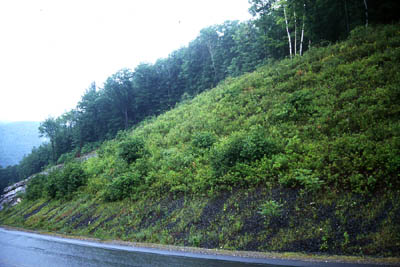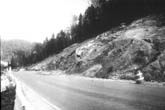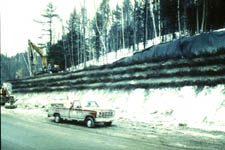Robbin B. Sotir & Associates, Inc.
Case Study: Colrain, Massachusetts
Location: Colrain, Massachusetts
Client: Massachusetts DOT and FHWA
Objectives: Soil bioengineering slope stabilization and revegetation for a new road construction on an unstable slope.

Nature of Firm's Resonsibility
 During the upgrading of Greenfield Road, oversteepening, increased slope height and seepage
caused numerous slope failures along the length of the cut. Concrete retaining walls proposed for
slope stabilization were rejected when it was discovered that the bedrock was highly fractured schist
and the cost of the required footings would be considerable. Due to the visual starkness and environmental
incompatibility, local residents would not accept a design to blanket the slope with crushed rock. The
favored solution of soil bioengineering combined both engineering mechanical requirements and environmental
benefits that were visually non-intrusive and would blend in with the natural surroundings.
During the upgrading of Greenfield Road, oversteepening, increased slope height and seepage
caused numerous slope failures along the length of the cut. Concrete retaining walls proposed for
slope stabilization were rejected when it was discovered that the bedrock was highly fractured schist
and the cost of the required footings would be considerable. Due to the visual starkness and environmental
incompatibility, local residents would not accept a design to blanket the slope with crushed rock. The
favored solution of soil bioengineering combined both engineering mechanical requirements and environmental
benefits that were visually non-intrusive and would blend in with the natural surroundings.
 Following detailed stability analysis and after considering several alternatives, soil bioengineering fill
brushlayer and live fascines were determined to provide a low risk and cost effective solution. The brush
layers were installed above a 10-foot high, 8-foot thick rock buttress that was required to stabilize the
critical failure zone through the toe of the slope and to provide site distance for drivers, and easy snow removal.
The project served to demonstrate to the FHWA and the Commonwealth of Massachusetts that soil bioengineering could be
used most effectively in combination with conventional engineering to stabilize a cut slope.
Following detailed stability analysis and after considering several alternatives, soil bioengineering fill
brushlayer and live fascines were determined to provide a low risk and cost effective solution. The brush
layers were installed above a 10-foot high, 8-foot thick rock buttress that was required to stabilize the
critical failure zone through the toe of the slope and to provide site distance for drivers, and easy snow removal.
The project served to demonstrate to the FHWA and the Commonwealth of Massachusetts that soil bioengineering could be
used most effectively in combination with conventional engineering to stabilize a cut slope.
The project was completed in the fall/winter of 1989/90. It is an excellent example of using soil bioengineering technology to rebuild structural and ecological function back into a system, optimizing both.
Several technical papers have been published on this project.
3602 Ernest W. Barrett Parkway
Marietta, Georgia 30064-2732
Phone: 770-424-0719
sotir@sotir.com
©2001 Robbin B. Sotir & Asociates, Inc.